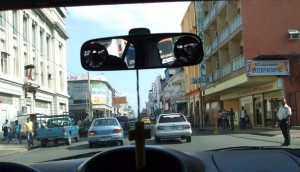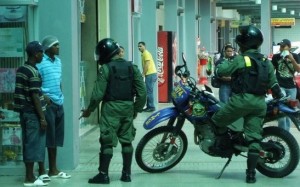The trip into town today was long, but ended up going pretty well. Because no overhead bridge has been built, the bus has to pass through the Panama Canal on a sort of drawbridge at the Gatun locks to get into town. When there are ships in or approaching the locks, which is almost all the time, the bus and all other traffic has to stop and wait. The wait was about half an hour today and doubled the time it took to get to town. I had the good fortune to sit by some other really interesting cruisers both to and from town, so we spent most of the time in conversations about their adventures to date, which so far dwarf ours. We’re planning to put up a blog about some of the different people we have met and their stories.
When we finally reached the shopping center at Colon, someone on the bus was able to give me good directions to where I was headed, and the bus driver dropped me off not too far away. Walking in downtown Colon is a health risk for a tourist, so I was happy to be able to catch a cab dropping off passengers at the corner fairly quickly. I lucked out and got a really nice cabbie that spoke English fluently. It turns out his grandparents came to Panama to help build the canal, learned English from the Americans, and taught the kids at home. The stop at the canal admeasurement office in the port was a breeze; everyone spoke fluent English, and they only had about 5 questions, so I’m not sure why we couldn’t have done it over the phone, but I guess that’s the system. Anyway, we should have an admeasurer visit us tomorrow to inspect us for our transit.
After such a short stop, I still had an hour or two to kill, so I asked the cabbie to show me around Colon. We’d seen most of the inner downtown area on our previous trips so he mostly took me around the outskirts of town, which are a little nicer. He had some answers and insights that may or may not be true, but were interesting. He said that much of the downtown portion of the city of Colon was originally built by the Americans as part of the canal project and remained a pretty nice place until 1969 when a military head of state declared that tenants were no longer required to pay rent. Landlords couldn’t collect rent or evict tenants after that so the buildings fell into disrepair and still look pretty rough today. He attributed the violence in Colon to two primary factors. The first was the gangs of young males with handguns, which he noted were a problem all over the world, including the US. The second factor was the small size of Colon — roughly 16 x 16 streets (not counting the industrial/retail duty free zone) which leaves most “parts of town” within walking distance of each other. We saw several more upscale residential areas, and like other cabbies, he explained that “this is where the Arabs live”. Apparently Arabs, Israelis, Chinese, and Indians own the majority of businesses & property in Colon (we’re hoping this will translate into some good Middle Eastern cuisine later this week). The minimum wage in Panama is $1.50/hour, but he didn’t say how many people actually earn that. There’s definitely a lot of poverty, but there are also a lot of cars on the streets (mostly Asian sedans and buses). Colon has no functioning stop signs or traffic lights that we’ve noticed yet, so the taxi rides through town are pretty entertaining at intersections.
One cool piece of news is that Wes and I have been able to find an unpaid job as linehandlers for another boat on our dock that’s headed through the Canal Sunday night and Monday. Each yacht is required to have four linehandlers in addition to a helmsman for the transit. Some boats hire guys through their agent, some people fly in friends, and others recruit from the boats in the marina or the sign-up sheet on the office. (In our case, we only need one additional person and intended to recruit a fellow cruiser, but it turns out that we have to hire a Panamanian who will take back the lines we are renting following our transit.) We’re going through with a South African couple on an owner-built Wharram-designed Tiki 38 catamaran. It’s a pretty boat that’s very well maintained, we like the couple, and we’re really glad to be able to go through once while helping someone else before we take our own boat through so we can find out what it’s like.



